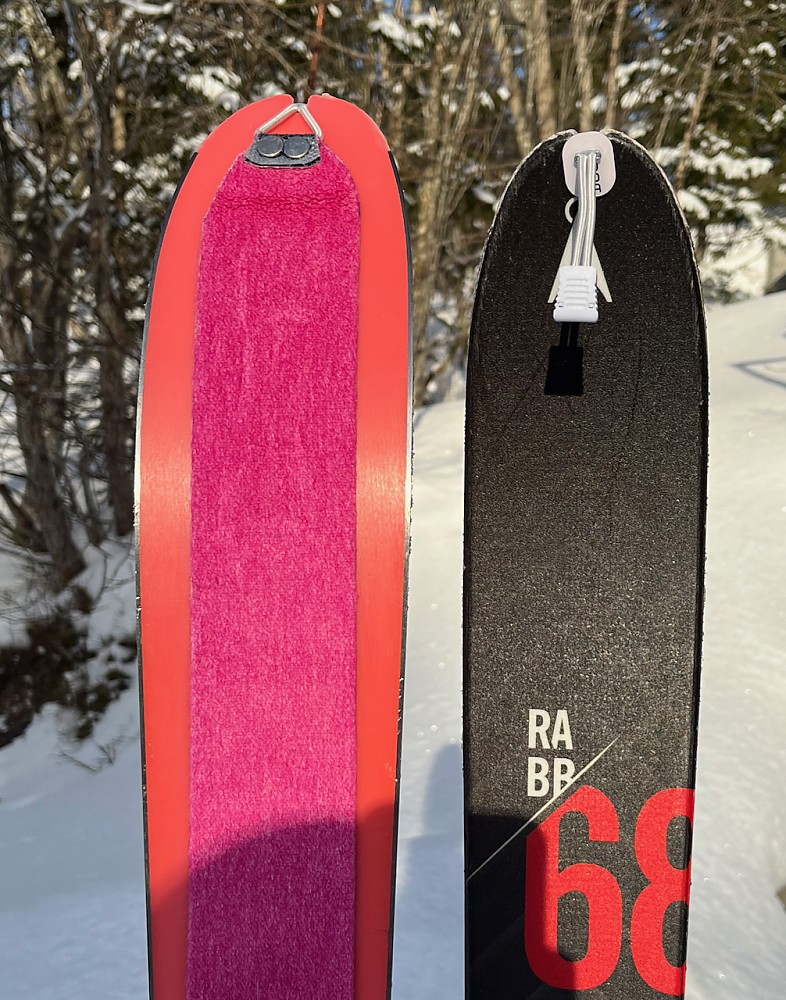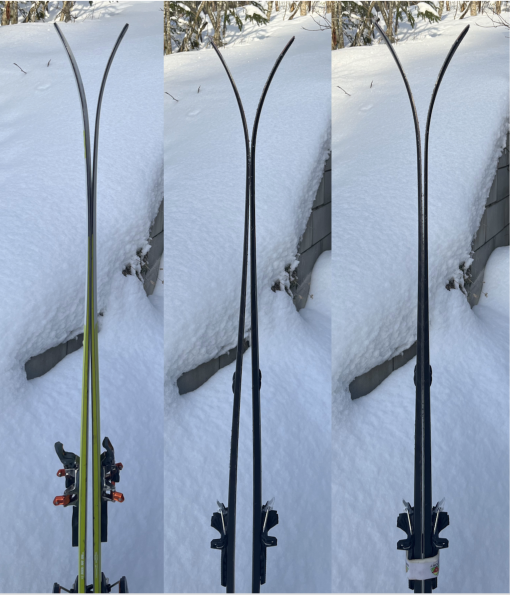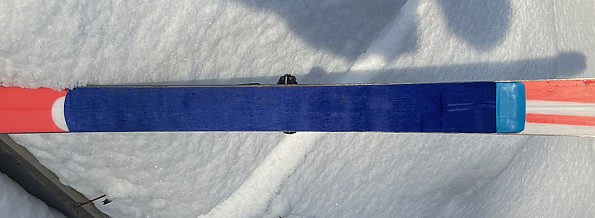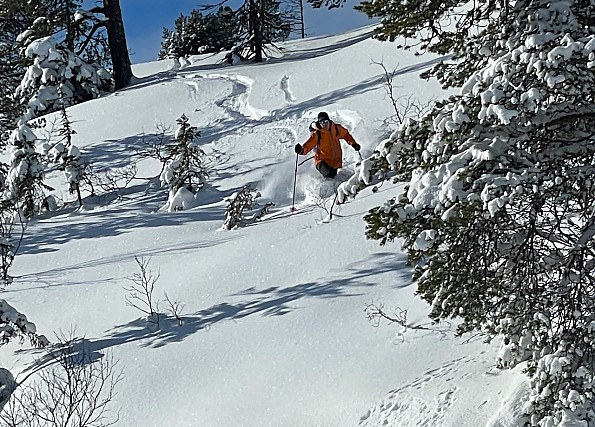Åsnes Rabb 68

A high-performance, lightweight, and wide mountain ski that tours well enough for hut-to-hut adventures and turns well enough for some summits on the side. Best in friendly snow conditions, but can handle some degree of crust and crud. Requires some driving rather than just riding in difficult snow.
Pros
- Broad tip and deep sidecut for good turning performance (for a mountain ski)
- Lightweight wood core carbon-reinforced construction
- "Nordic rocker" for staying on top of deep heavy snow
- Cambered mid-ski for touring performance
- Skinlock system for short skins, tip and tail notches for performance skins
- Suitable for backcountry-weight boots and bindings for an overall light system
Cons
- Can require more aggressive technique in difficult snow (than a big rando or telemark ski)
- Not your friend on hardpack
Here's the deal: you’re coming to Norway for a multiday hut-to-hut ski tour, with side trips to big slopes and summits, in late March or April when the mountain gods may offer up anything from fresh powder to creamed corn to nasty crust and ice. One pair of skis, boots, and bindings for the whole show. What’s your choice?
I asked that question on a backcountry skier's forum and got suggestions ranging from old school leather boot/3-pin binding/skinny ski setups through to lightened-up plastic rando or tele boots and bindings on no-compromise fat skis with rocker. I have tried to work the middle of that range for my entire backcountry ski career, on many ascents and descents in Vermont trees and probably a couple thousand kilometers of hut-to-hut skiing in Norway, often peak bagging along the way. With the right gear, a good skier can efficiently ski 20+ kilometers between huts in the morning and still have some fun downhill time in the afternoon.
My latest entry in the search for the backcountry holy grail is the rig I bought as a package deal two years ago: the Asnes Rabb 68 ski, Rottefella’s (relatively) new Xplore binding, and the Alfa Free Xplore-compatible boot. Over one full and two half seasons I have used that setup for multiple tours per week, mostly for “urban backcountry” skiing in Bymarka, Trondheim’s big outdoor playground. Bymarka has well over 100 km of groomed xc trails, with powder passages of varying length and steepness between and above them—if you know where to look.
From where I live, a day’s play might involve a 5 or 6 km slog on the xc trails, then maybe some yoyo runs on a favorite hilltop, ending with the slog back home. I have also used the Rabbs on weekend and longer hut-to-hut tours, with side trips to summits along the way, in midwinter and spring conditions. So in total, probably several hundred kilometers and several thousand meters of vertical. And it’s been (mostly) a lot of fun!
Look and feel

The Rabb 68 has a poplar/Pawlonia wood core with carbon fiber reinforced cap construction. The current model is a staid black with red and white text accents on top and pink sintered base with a shallow groove. It also has Skinlock slots ahead of the binding for attaching short skins that cover just the middle third of the ski.
My 188s weigh 2360g/pair, and with the Xplore binding and Alfa Free boot I get about 2360 g/foot (so the boot plus binding weigh about the same as the ski) as compared to about 3770 g/foot for my full-on rando rig. It comes with tip and tail notches that will work with lightweight rando-racing style skins with or without tail hooks. The weight savings extend to skins: my 70mm short skins weigh 70 g each and the full-length race weight skins weigh 136 g each, while the full-coverage skins for my rando skis weigh in at 285 g each. That all adds up to a weight savings of over 1.5 kg or almost than 3.5 lbs per foot for climbing slopes steep enough to require full-length skins!
The Rabb 68 is at the upper limit of what can be considered, in Norwegian nomenclature, a fjellski (mountain ski). The other end of the fjellski spectrum consists of narrower, steel-edged, high-cambered xc-style skis that are OK for getting between huts but not so much for swinging down the mountainsides. The Rabb’s 104-68-94 profile gives 36 mm of sidecut, probably more than any other ski in the fjellski class, and a nominal 19.8 m turning radius in my 188 cm pair.
The deep sidecut, small waist, and low weight resemble a modern rando racing (skimo) ski, differing mainly in having a relatively high camber mid-ski for more even weight distribution along the length of the ski and therefore better gliding performance on the kick-and-glide side of the equation. The stiffer camber also means that the ski is less responsive than the deep sidecut would seem to promise; I find that these skis need some driving, rather than just riding, especially in more demanding conditions.
These skis are way too wide to fit into a groomed xc ski track, so I have to ski along the side or in the skate lane on approaches using xc trails, and they tend to wander on packed snow. They are much happier breaking trail in untouched snow. And when it comes to making turns, the aren't much fun on hard-packed snow, especially with a backcountry-weight boot like the Alfa Free.
Rockin’ the tip rise

L to R: an off-piste rando ski at rest, Rabb 68 at rest, Rabb 68 decambered
The high camber is offset by a welcome innovation, called “Nordic rocker”. Modern downhill skis designed for soft snow usually have some degree of rocker or tip rise: put the ski bases together and you can see that the relatively flat skis actually curve apart beginning some distance back from the tips, so that the skis tend to (delightfully!) ride up out of deep, heavy snow rather than submarining as older designs sometimes do.
Put a pair of Rabbs together and they look like those older skis, meeting at the shovel and tail with the skis arched apart in between. But squeeze them together at mid-ski, and the tips move apart, giving some tip rise on the fully weighted ski. The result is easier turn initiation as well as a tendency to ride up out of soft snow. The high camber mid-ski means that the ski will still flatten and glide decently in xc mode, especially if the snow isn’t too hard.
But does it work? I think so. I have used the Rabbs on countless short powder runs using both tele and alpine technique, but also in more demanding conditions—powder with a light rain crust or heavy wet spring snow. They don’t float or initiate turns as well as my big rando skis, but they do a lot better than any other mountain ski that I have used over the years.
Adventures in the skin (and wax) trade
I use the 70 mm Åsnes Access short skins, trimmed a bit to fit the waist of the ski, extensively, often for yoyo skiing on short runs. They won’t climb as steeply as a full-length skin, so I have to cut shallower traverses, but they otherwise do the job at something like 1/3 the weight and bulk of a full-length ski—I stash them in a jacket pocket between runs.

More recently I custom-built a pair of full-length, hot pink, racing weight Pomoca skins, using the TipFix system that sets into the tip notch on the ski, for full climbing power. The are lighter and less bulky than the rather ancient skins I had been using, and stick well enough to climb straight up 20-25˚ slopes.

Although the Rabbs do not have a wax pocket, which would compromise turning performance, I use hard wax in cold snow conditions without any issues. If the snow isn’t too abrasive I can go all day on a single kick-wax job. In wet snow I switch to 20 mm short skins so as to avoid using klister—slower than a waxed ski on the xc trails but again it does the job.
Giving it the boot
The Rabb is a big enough ski to demand a bigger boot to drive it. 75mm diehards might want a Scarpa T4 or a high-top leather boot, for NNN-BC a high and stiff leather boot (i.e. Alpina Alaska) or one with a plastic cuff (i.e. Crispi Svartisen). For my part, the new(ish) Xplore binding and Alfa Free boot have served me well, but there are other Xplore boot options already on the market, and perhaps more to come.
Word
At the end of Easter week last spring, I put the Rabbs to their best and highest use on a two-night hut tour with my wife. We skied about 20 km into our first hut in windy and low-visibility conditions. The next two days offered up perfect spring weather, so we used the next morning to ski to the next hut, then in the afternoon I ascended a nearby peak and skied back down in a north facing bowl filled up with heavy, wind-settled powder.
On day three I waited until mid-morning for the snow to soften, then dashed up and down another nearby peak, descending this time in deep, sun-roasted corn snow, in under four hours. That afternoon and we skied the 20 rolling km back out to the road, ending rather late with a final run in difficult, crusted-over spring corn snow. It sometimes took some work to initiate turns on the slopes and keep the Rabbs pointed straight ahead on a hard-packed trail, but they did the job. And they’ll do it again.
There is no such thing as a perfect compromise ski that will both kick and glide effortlessly and offer the float and turning performance to shred deep crud on a sun-baked April mountainside. But for my purposes, the Rabb 68 is about as close as I’ve come to that ideal in over 40 years of trying. I’d recommend it for strong skiers that want the turning performance of a relatively big fjellski, but still want a lightweight and somewhat versatile rig for approaches and getting to the next hut. For full-on backcountry downhill or on-piste performance, you’re better off with a rando or heavy tele setup.
Background
I have been a skier for over 60 years and a backcountry and telemark skier for over 40. I did my first hut-to-hut tours in Norway during a visit in 1984, and have done many more in the 20+ years that I have lived here, usually with summit ascents and descents along the way. I have put in two full seasons with the Rabb 68 as my main all-round backcountry ski. I use rando gear for ski mountaineering on steeper terrain, usually only on day trips.
Source: bought it new
Price Paid: About NOK 3400 ($340)



